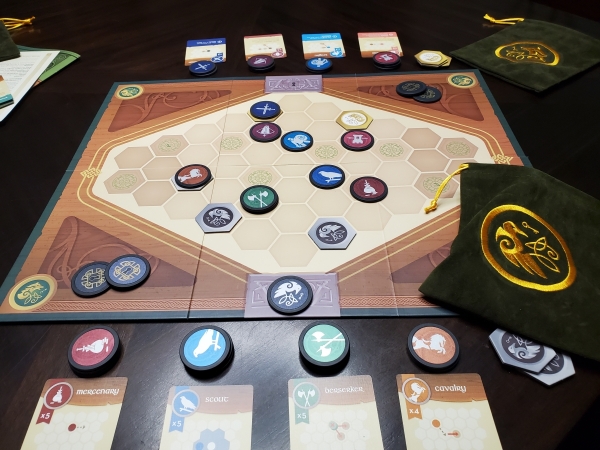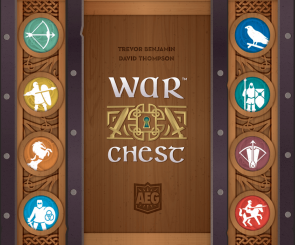Sometimes it's the feel of the game that really snares you.
For those of you who've played poker or have watched regular pros play, there will often be a lot of chip shuffling. A lot of players need either a focus or a distraction while they're playing and get in the habit of manipulating chips (stacking and re-stacking, riffling, etc.) while they're playing. For card games that tend to have larger numbers of cards actually in hand, you'll see a similar behavior with cards. A lot of Magic:The Gathering players are known for rapidly and repeatedly sorting through their hands. Those are tactile sensations that either keep a portion of their brain distracted or act as a focus while they try to anticipate what's happening in the game in front of them. War Chest, a game by Trevor Benjamin and David Thompson, is a similar kind of experience for a number of reasons. It's a 2- or 4-player tactical war game where all the units are heavy coins that you collect in bags from which to draw a random selection and then either play them to the board or discard them to move the units already on the board. Whereas many games can activate the sense of sight with elaborate artwork or cool minis or even the sense of smell when first opening the box, War Chest is one of the more satisfactory games I've played that stimulates the sense of touch. As opposed to the light and often delicate wooden or plastic pieces of most other releases in the modern era, these unit coins are remarkably solid and have real heft. You can play them to the board with an audible "thunk" every time and shuffling the coins in your hand, just like poker chips, is one of the more entrancing activities I've done at a game table in recent years. Combine that with the smooth and simple artwork, the easy-to-read iconography, the simple rules, the thick, embroidered bags, and even the nice box, designed to resemble a wooden chest with a magnetic clasp on the closing flap, makes this one of the best physical presentations of the past few years. Everything about this game's look and feel speaks to the care and attention that went into its physical design. Thankfully, that same care and attention was applied to its gameplay, as well.

The coins are the (ahem) universal currency of the game. You build your bag similarly to deckbuilders, in that you begin with a certain number of each of your four different units in your bag and can add more as you go along. You can have only one of each type of unit on the board at a time, but can add more coins to that unit (bolstering; so it can take more hits) simply by drawing the right one. Maneuvering a unit on the board (move, attack, tactic (special attack), or control a location; controlling six locations wins the game) means discarding the same type of coin face up. But recruiting more coins or taking the initiative from your opponent can be done with any coin face down. You want to keep your bag relatively sparse to ensure that you draw the coins you want to maneuver on the board. But you also want to have more options so that you can keep multiple units in useful or threatening positions as often as possible. That creates a great tension for how you build your bag as you try to find the balance between efficiency and versatility in the game. It also creates tension for your opponent, as most units are limited to moving or attacking and it's rare that both will happen in a single draw. So players will often have to roll up next to an opposing unit that they want to remove, but have to wait a turn before they can, banking on the idea that the opposition doesn't have the right coin in hand that will let them kill before being killed. In that way, we hearken back to those games (like poker) where you often play the player, rather than the cards in hand. What does your opponent's previous turn tell you about what they have in hand? What are their eyes telling you about the risk of moving your Footman next to their Heavy Cavalry?

As you might expect, with the limited number of units in play at any time and the simple but elegant rules, War Chest games don't go on for very long, either; usually lasting about a half hour, at most. But there's significant depth in the game as a whole. With 16 units in the base game and another four each added in both of the expansions (Nobility and Siege), the combinations available are considerable, especially considering how different units will shine against different opposition. Did your opponent go heavy on mobility with Scout and Light Cavalry? Well, having Knights and Archers should be an effective answer, since they won't be able to attack the former while unbolstered and can be picked off by the latter across half the board. But some of the real joys are discovering the ways in which particular units can interact directly with the game's bag-building and drawing systems like the Mercenary, who can maneuver every time you recruit another Mercenary, or the Warrior Priest who allows you to draw and use another coin whenever it attacks or controls. Finding those little combos, measured against that essential tension of being able to draw more of the units you really want without completely abandoning the rest of your force in play is what generates a lot of the brow-wrinkling that the game encourages.

Both expansions provide greater texture in a different way. Nobility adds the Decree system, which are three single-use actions that both players can take advantage of during the game. Most of them are comprised of actions taken outside the normal system or enhanced versions of the usual ones, like recruiting twice or taking a unit off the board and then redeploying it somewhere else. As with similar mechanics in other games, knowing when to exercise the one time you can spy on an opponent's hand and discard one of their coins may be, as with many ancient battles, the key moment that assures victory or the famous chance that was wasted. Two units in the expansion- the Earl and the Herald -have abilities that are directly connected to the Decrees. Similarly, the Siege expansion introduces the Fortification system for a somewhat slower and more methodical game (enemy units in Fortifications can't be attacked until the Fortification is destroyed) but only one unit- the Sapper -is directly connected to the system, although the rest must be bolstered to use their tactics. Even with the slower pace, Siege doesn't overstay its welcome and experienced players should be able to adapt quite quickly to the new requirements and new possibilities.

I've rarely found a game that simply feels so satisfying to play, whether it's pulling another hand of three heavy coins into your hand or sliding one across the board until it makes contact with another, opponent or ally, with an audible "click." Despite having a variety of unit abilities and functions, the overall design retains enough of the feel of an abstract to make one imagine playing a slightly more advanced version of chess and many of the choices that War Chest players make will be similar, as formations and positions on the simple, hexagonal board will be similarly constructed and arrived at. As with many games, play will really accelerate and reach its peak with more experienced players who are willing to draft their units to try to develop those inherent combos and synchronicities. At least in this case, the answer to the famous "What's in the box?" is "A really remarkable package."
 Games
Games How to resolve AdBlock issue?
How to resolve AdBlock issue? 
























